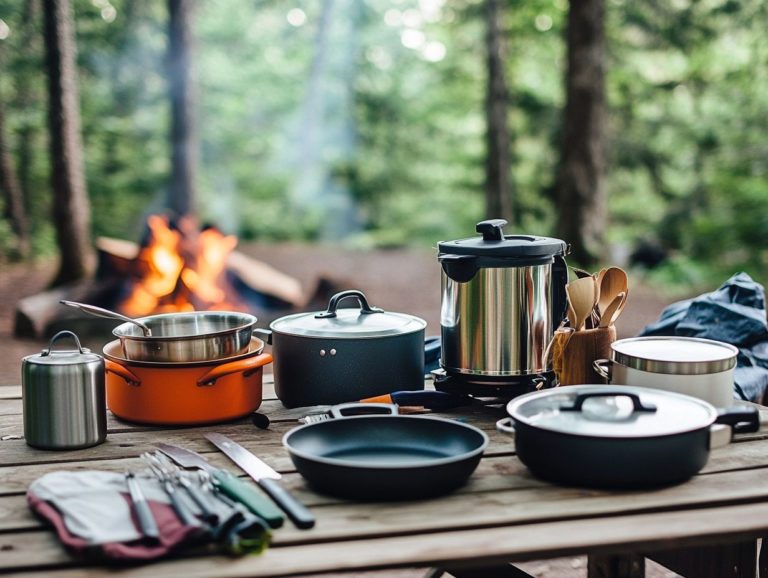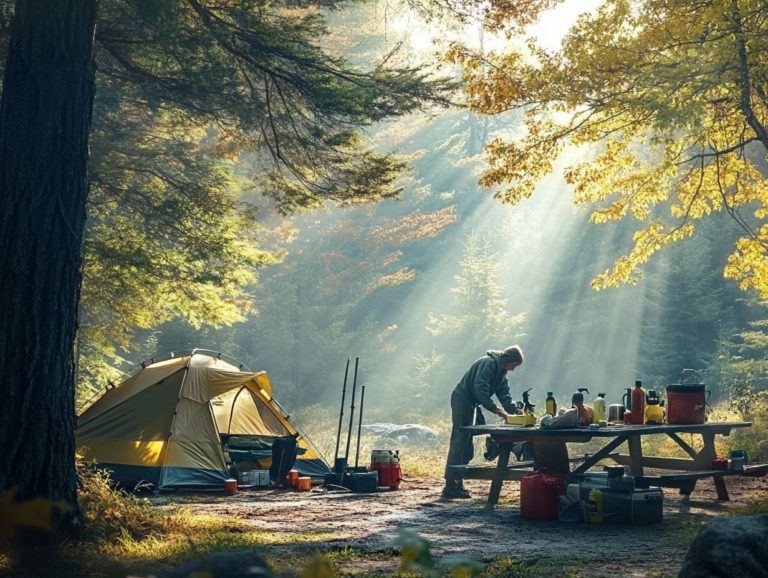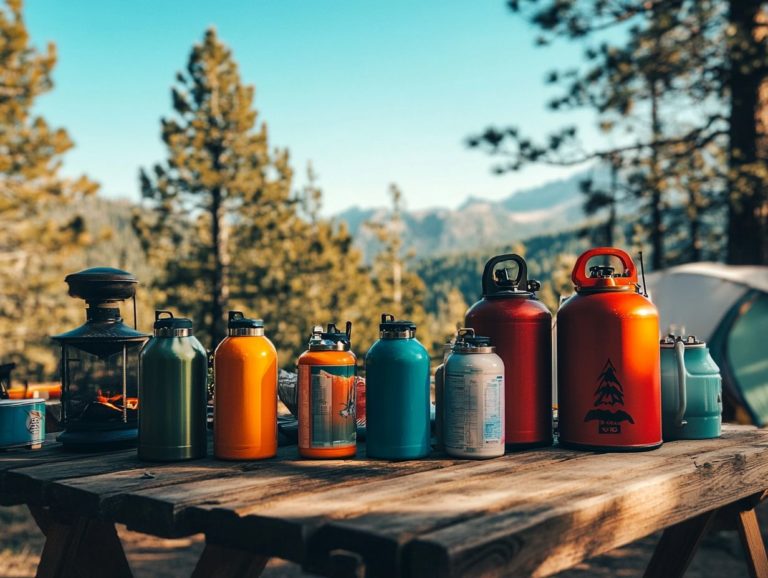Best Lightweight Tents for Backpackers
When embarking on your backpacking journey, selecting the right tent can truly transform your adventure. Opting for a lightweight tent not only alleviates the strain on your back but also equips you to handle a variety of environmental conditions with ease.
This article delves into the various types of lightweight tents, highlights essential factors to consider, and presents a curated list of the finest options tailored for backpackers like you. You’ll also discover valuable tips on setup, maintenance, and packing, ensuring you maximize your outdoor experience.
Let’s find the perfect tent for your next adventure! Let s dive in!
Contents
- Key Takeaways:
- 1. Types of Lightweight Tents
- 2. Factors to Consider When Choosing a Lightweight Tent
- 3. Top 5 Lightweight Tents for Backpackers
- 4. Comparison of Features and Prices
- 5. How to Properly Set Up a Lightweight Tent
- 6. Tips for Maintaining and Cleaning Your Lightweight Tent
- 7. Common Mistakes to Avoid When Using a Lightweight Tent
- 8. How to Pack a Lightweight Tent for Backpacking
- 9. Lightweight Tent Accessories That Can Enhance Your Camping Experience
- 10. Budget-Friendly Options for Lightweight Tents
- 11. How to Choose the Right Size and Capacity for Your Lightweight Tent
- 12. The Importance of Durability and Weather Resistance in a Lightweight Tent
- 13. User Reviews and Recommendations for Lightweight Tents
- 14. How to Determine If a Lightweight Tent Is Suitable for Your Backpacking Trip
- Frequently Asked Questions
- What are the key factors to consider when choosing the best lightweight tent for backpackers?
- Are there any specific materials that make a tent lightweight?
- Can a lightweight tent still offer enough protection and comfort for backpackers?
- What is the ideal weight range for a lightweight backpacking tent?
- Are there any features that are essential for a lightweight tent for backpackers?
- Do I need to sacrifice durability for a lightweight tent?
Key Takeaways:
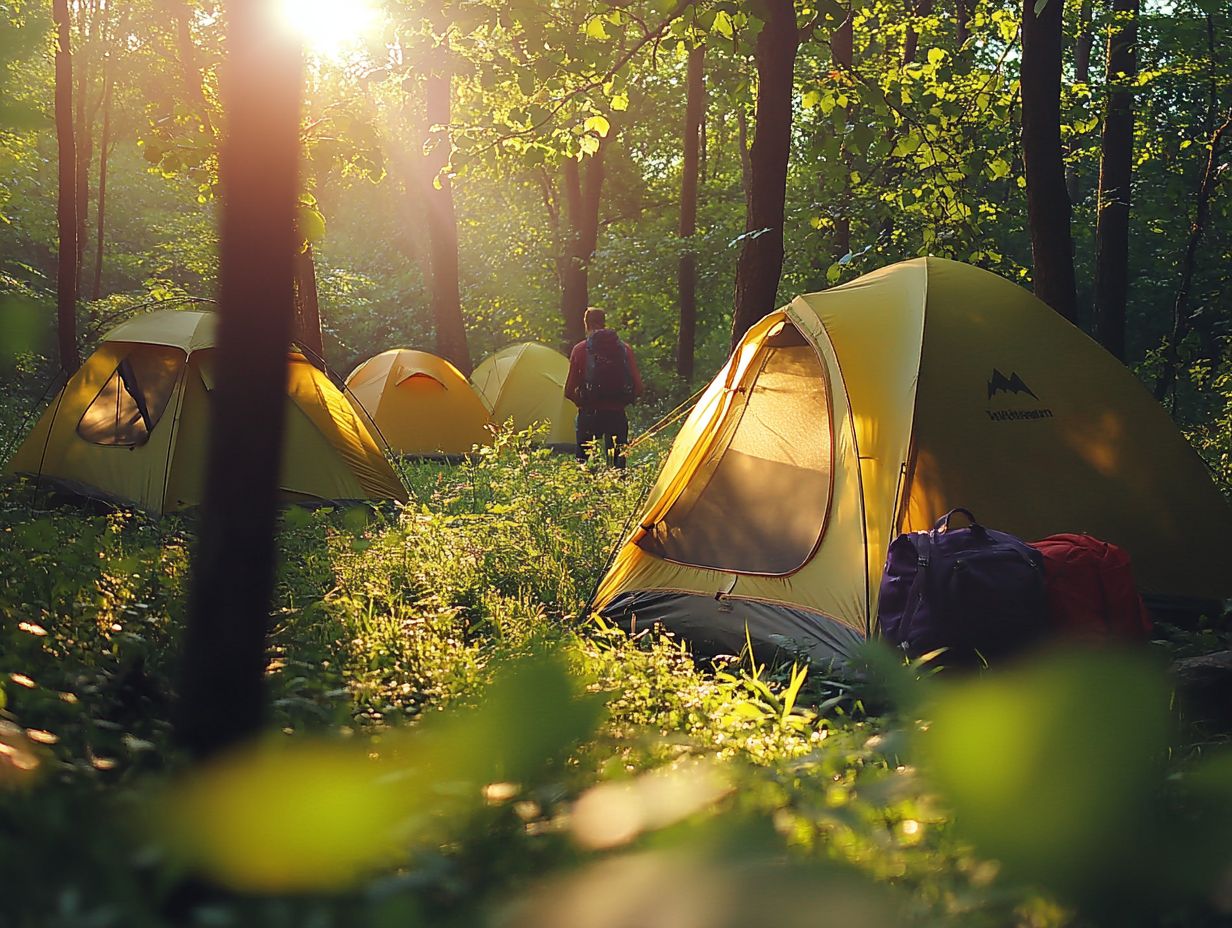
- Invest in a lightweight tent that suits your specific needs and budget.
- Consider factors such as size, durability, and weather resistance when choosing a lightweight tent.
- Properly set up, maintain, and pack your lightweight tent to ensure a comfortable and hassle-free backpacking experience.
1. Types of Lightweight Tents
Lightweight tents are a critical component of your outdoor gear collection. They are especially designed for backpackers like you. You ll find a variety of options ultralight tents, freestanding models, and budget-friendly choices all tailored to suit different camping conditions, preferences, and your desire for ample interior space and headroom.
If you re a minimalist adventurer, ultralight tents are your best ally. They provide exceptional portability without compromising on durability. They re perfect for those long treks where every ounce matters.
If you value quick setup and stability, go for freestanding tents, which can stand on their own without stakes. This feature allows you to hit the trail without a hitch.
For a more versatile approach, consider backpacking tarps. These can serve as rainflies or be creatively configured into various shapes to adapt to your environment.
Each type of tent enhances your camping comfort and elevates your overall experience, seamlessly fitting into your outdoor adventures, whether it’s a weekend hike or an extended wilderness expedition.
2. Factors to Consider When Choosing a Lightweight Tent
When choosing the best backpacking tent, it’s essential to weigh several key factors: water resistance, weight reduction, interior space, price, durability, and user-friendly design. Each of these elements significantly enhances your comfort and influences the tent’s overall performance across various weather conditions and terrains.
Water resistance is non-negotiable; it keeps you dry and comfortable because let’s face it nobody enjoys a soggy night in the wild. Weight reduction matters too, as it makes your gear much easier to carry on those long treks.
You ll want adequate interior space for both sleeping and storing your equipment. Durability ensures your tent can brave the elements and the outdoor rigors. A user-friendly design is invaluable, allowing for quick setup and takedown, which is essential when you want to maximize your outdoor time.
For example, tents like the Big Agnes Copper Spur HV UL, Half Dome SL 2+, or the REI Co-op Flash Air strike the perfect balance among these attributes, making them outstanding options for discerning backpackers. For more guidance, check out choosing the right backpacking tent to fit your needs.
3. Top 5 Lightweight Tents for Backpackers
When selecting the top 5 lightweight tents for backpackers, options like the Copper Spur HV UL2 and the Half Dome SL 2+ truly stand out. Each of these tents brings its own unique lightweight features, spacious interiors, and proven camping performance, catering to a range of budgets.
These tents aren t just about being easy to carry; they also prioritize comfort and durability in various weather conditions. If weight is your top concern but you refuse to compromise on space, these tents strike an excellent balance between comfort and packability, making them ideal for those extended treks.
By diving into the feedback from seasoned campers, you can uncover valuable insights into the usability and performance of these models. Whether you’re gearing up for an adventurous mountain climb or a relaxed weekend escape, understanding the specifications, pros and cons, and ideal use cases for these tents will enable you to make an informed choice.
4. Comparison of Features and Prices
Discover the best lightweight tents for your next outdoor adventure! A comprehensive comparison of features and prices among top lightweight tents offers valuable insights into their camping performance, innovative design elements, and overall worth. This helps you identify the best options for your outdoor adventures.
By evaluating aspects such as weight, ease of setup, weather resistance, and available space, you’ll quickly see how each model meets the demands of various camping environments and user preferences. For example, some tents are made for ultra-light backpacking trips, prioritizing weight and packability, while others shine by providing additional interior space or superior durability for family camping scenarios. Additionally, consider the top 5 lightweight sleeping bags for hikers to complement your outdoor gear.
The pricing spectrum is also important; budget-friendly options often come at the expense of advanced features, settling for a more basic design. User experiences, shared through reviews and testimonials, can further illuminate the real-world performance of these tents, guiding you toward informed decisions that align perfectly with your specific outdoor needs and expectations.
5. How to Properly Set Up a Lightweight Tent
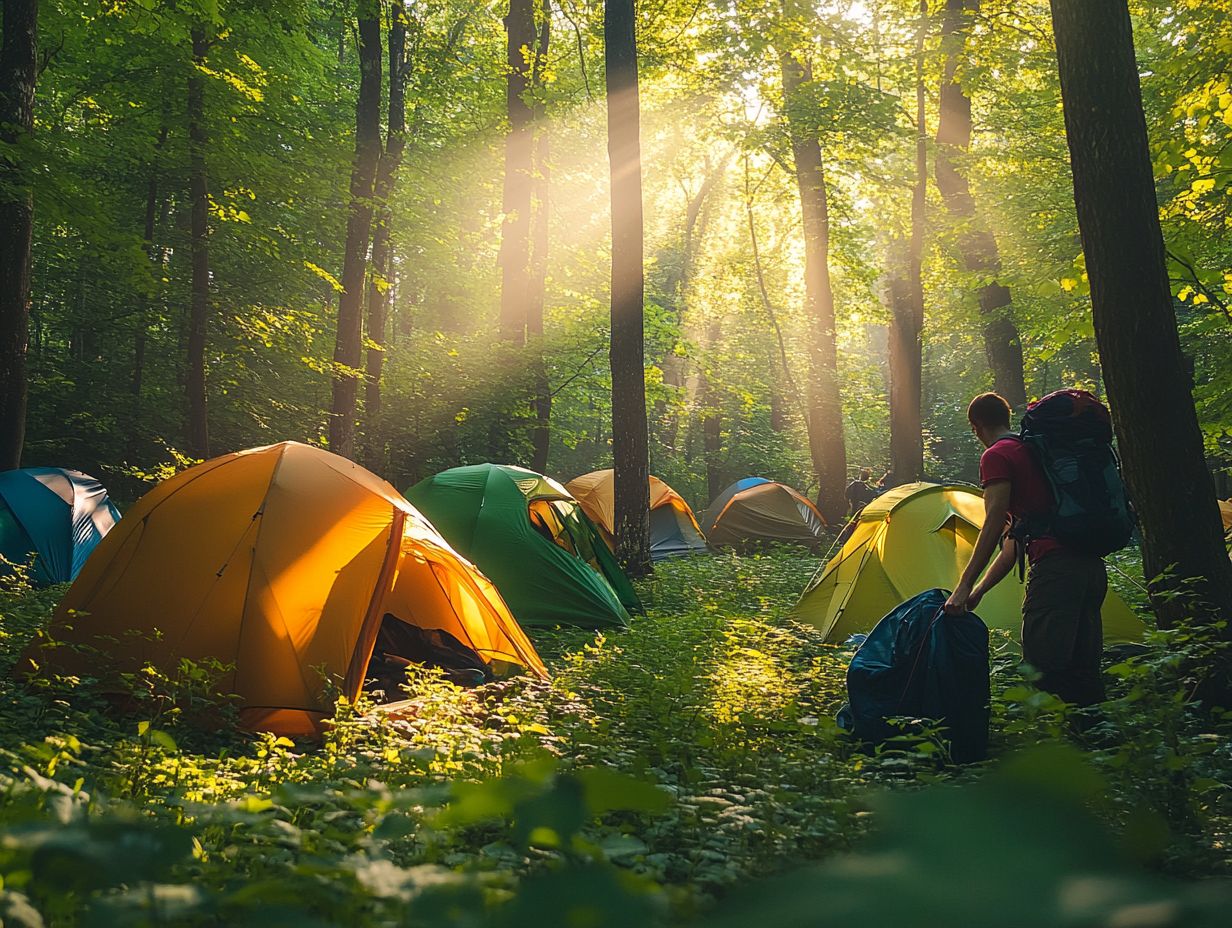
Properly setting up a lightweight tent is essential for maximizing its user-friendly features, ensuring a secure pole configuration, and optimizing vestibule space for a truly comfortable outdoor experience.
-
To start, select a flat, dry location free of sharp debris that could damage your tent floor. Unfold the tent and lay it out, taking note of the entry point and the internal pockets designed for storing your gear.
-
Next, secure the tent poles, ensuring they slide effortlessly into the designated sleeves or clips. Forcing them can compromise the poles’ integrity, which is the last thing you want.
-
As you pitch the tent, stake out the corners tightly. This not only provides stability but also maximizes airflow, keeping things comfortable inside.
-
To enhance waterproofing, consider placing a ground tarp underneath, and always double-check that the rainfly is properly aligned and securely fastened. This will help you avoid leaks during those unexpected downpours.
By following these steps, you ll make your camping experience more enjoyable and hassle-free.
6. Tips for Maintaining and Cleaning Your Lightweight Tent
Regular maintenance and cleaning of your lightweight tent are crucial for ensuring its longevity and optimal performance, especially regarding waterproofness and the quality of materials used in outdoor gear.
To effectively care for this essential piece of equipment, consider establishing a routine that includes:
- Cleaning the tent after each use, paying particular attention to areas prone to dirt or moisture.
- Using gentle soap and water to wipe down the fabric, ensuring you follow up with a thorough rinse to eliminate any residue that might compromise its quality.
- Ensuring the tent is completely dry before packing it away to prevent mold and mildew growth.
Applying protective sprays designed for tent fabric enhances its waterproof capabilities. These sprays help keep your tent waterproof and in good shape. Don t forget to regularly inspect and lubricate the zippers to maintain their functionality and prevent any annoying snagging.
Act now to significantly extend your tent’s lifespan and enjoy countless outdoor adventures worry-free!
7. Common Mistakes to Avoid When Using a Lightweight Tent
Avoiding common mistakes while using a lightweight tent can significantly elevate your camping experience, ensuring a more enjoyable outdoor adventure.
As you embark on your camping trip, it’s crucial to be mindful of the typical pitfalls that could potentially undermine this experience. Many campers unknowingly set up their tents incorrectly, leading to compromised stability and discomfort as the night unfolds. Overlooking weather conditions can result in unwelcome surprises, like unexpected rain or howling winds. Additionally, neglecting to assess the fabric’s durability could spell disaster, as a thinner material might not hold up against the elements.
To sidestep these issues, it s wise to practice setting up your tent before you hit the road, keep a close eye on weather forecasts, and invest in a tent made from high-quality materials designed to withstand various conditions.
8. How to Pack a Lightweight Tent for Backpacking
Packing your lightweight tent efficiently is key to keeping your backpack compact. This ensures easy access during your outdoor adventure!
To do this, it s crucial to fold and stow your tent in a way that reduces unnecessary bulk while maintaining its shape.
Start by laying the tent out flat and rolling it tightly. This not only saves space but also makes tent setup easier when you reach your destination.
When securing the tent and accessories like backpacking tarps, consider distributing the weight evenly in your backpack. Placing heavier items close to your back helps maintain balance on the trail.
Keep frequently needed gear such as stakes, the fly, or repair kits in outer pockets for quick access. This way, you’re always prepared for the unexpected while exploring the great outdoors.
9. Lightweight Tent Accessories That Can Enhance Your Camping Experience
Enhancing your camping experience with lightweight tent accessories like trekking poles and interior pockets can really boost your camping comfort!
Essentials like a portable footprint protect your tent s base from damage and moisture, which helps it last longer. Consider investing in lightweight sleeping pads or inflatable pillows that improve your rest quality by offering better insulation and support.
A spacious interior also enhances your overall experience, making it feel more comfortable.
A compact lantern brightens your campsite, making nighttime activities more enjoyable and safer. Using gear lofts optimizes your tent s space, keeping your personal items organized and easy to reach, which reduces clutter inside.
Choose a user-friendly tent design to make setup easier, allowing you to focus on enjoying your adventure!
Each of these accessories not only enhances comfort but also enriches your overall camping experience. This way, you can truly relax and immerse yourself in nature!
10. Budget-Friendly Options for Lightweight Tents
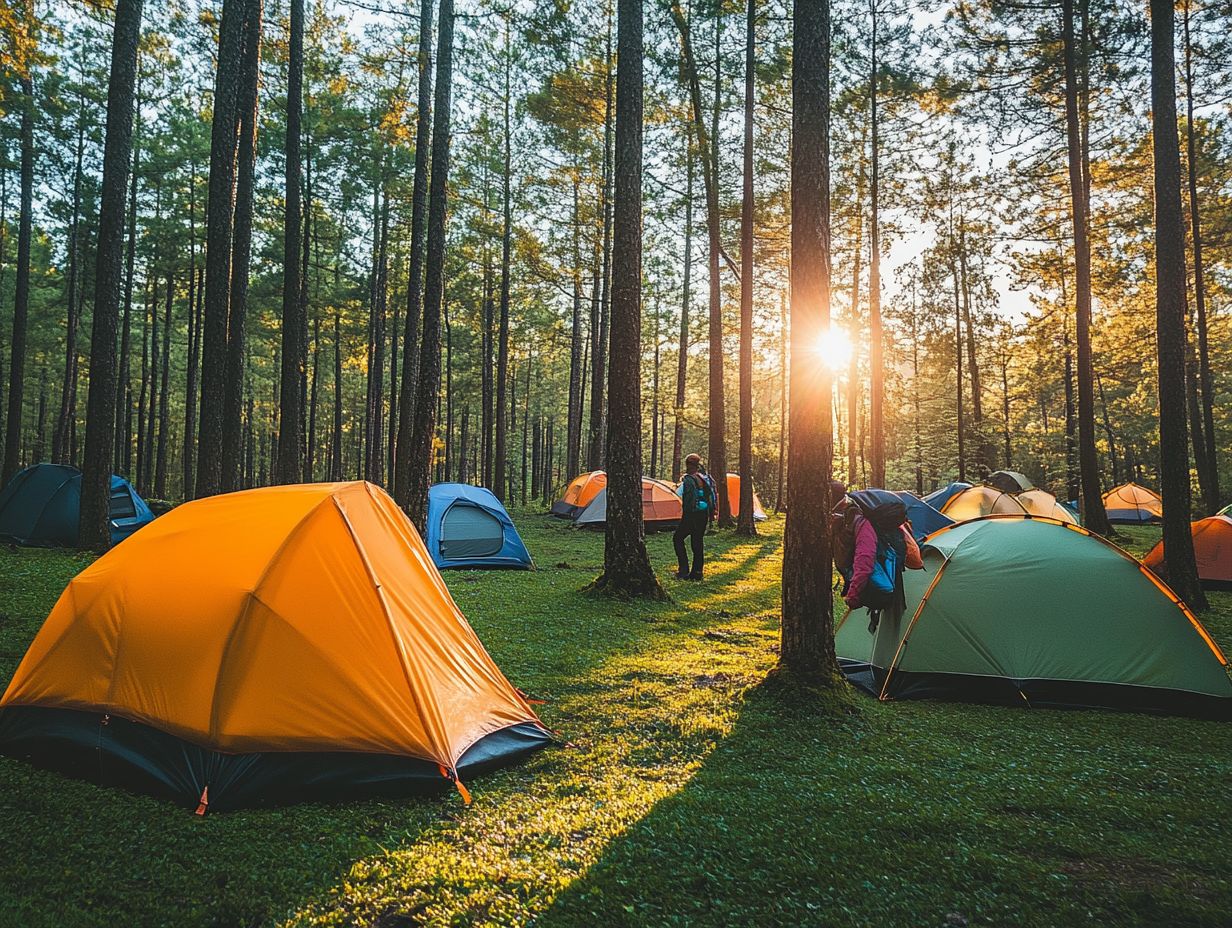
If you re looking for budget-friendly options, there are many affordable tents that offer great value without sacrificing key features. This makes them perfect for camping enthusiasts who want to keep costs low!
These options emphasize affordability while balancing quality and performance. For instance, the Coleman Sundome 2-Person Tent stands out for its weather-resistant fabric and easy setup. It’s perfect for both beginners and experienced campers! If you’re interested in more details, check out this guide on choosing the right tent for backpacking.
Another great choice is the REI Co-op Flash Air 2, which is an excellent lightweight option that doesn t compromise on durability. It s ideal for those planning to venture deeper into the wild or looking for a freestanding tent.
These tents show that you can enjoy the great outdoors without breaking the bank. Remember to read reviews to help you choose the best tent for your needs!
11. How to Choose the Right Size and Capacity for Your Lightweight Tent
Selecting the right size and capacity for your lightweight tent is crucial for creating a spacious interior that fits your camping needs and enhances your outdoor experience!
Choosing the appropriate tent size depends on the size of your group and the gear you plan to bring. For example, a 2-person tent is typically perfect for couples or solo adventurers who appreciate a minimalist setup.
This tent offers just enough space for sleeping and storing a few essentials. If you’re camping as a group, consider a 3-person tent to provide extra room.
A 3-person tent offers more wiggle room, making it suitable for small groups or individuals who prefer extra space for their gear. This added capacity is invaluable during inclement weather or when comfort is a priority, ensuring a more enjoyable outdoor experience!
12. The Importance of Durability and Weather Resistance in a Lightweight Tent
The durability and weather resistance of a lightweight tent are critical factors that dictate its performance in various camping conditions. It is essential to choose tents crafted from the finest materials available.
Consider materials like Dyneema fabric and Sil-Nylon. These materials are popular among outdoor enthusiasts for their exceptional strength and resilience. Dyneema is strong but light, significantly enhancing the tent’s ability to withstand harsh winds and sudden weather shifts. Meanwhile, Sil-Nylon is remarkably waterproof, ensuring your gear stays dry even in heavy downpours.
These qualities guarantee that your shelter can endure the challenges of the wilderness and contribute to its longevity. A quality tent provides years of dependable adventures and the best overall tent for your needs. By understanding these materials, you elevate your camping experience, allowing you to focus on exploration rather than worrying about your gear.
13. User Reviews and Recommendations for Lightweight Tents
User reviews and recommendations are invaluable in helping you pinpoint lightweight tents that deliver exceptional value and superior camping performance. These insights often shed light on key features like weather resistance, ease of setup, and overall durability, enabling you to evaluate your options more effectively.
Many reviews highlight how certain tents have bravely faced heavy rainfall or strong winds, offering you peace of mind during unpredictable weather moments. The reliability showcased in testimonials not only reassures you but also helps you make informed choices tailored to your adventurous spirit.
Customer feedback can unveil patterns in performance across various terrains. This ultimately influences what you prioritize when selecting the ideal tent for your next excursion, including camping essentials.
14. How to Determine If a Lightweight Tent Is Suitable for Your Backpacking Trip
Determining whether a lightweight tent is the right fit for your backpacking adventure requires careful consideration of its features, materials, and the specific camping conditions you ll encounter. This thoughtful approach ensures a successful outdoor experience and the best materials selection.
Evaluating weather conditions is paramount. Different tents perform variably when faced with rain, wind, or snow. The terrain you’ll navigate be it rocky, muddy, or flat can greatly influence your choice of tent, especially when considering weight reduction.
You’ll also want to consider the tent’s specifications, including its weight, size, and ease of setup. This is especially important if you’re aiming for a minimalist experience on the trail. Features like headroom and vestibule space are also essential.
To simplify your decision-making, create a checklist that highlights essential factors:
- Waterproof ratings
- Ventilation options
- The adequacy of guy lines
This systematic strategy will guide you toward finding a tent that perfectly aligns with your unique backpacking needs and ensures it exceeds your expectations for an unforgettable camping experience!
Frequently Asked Questions
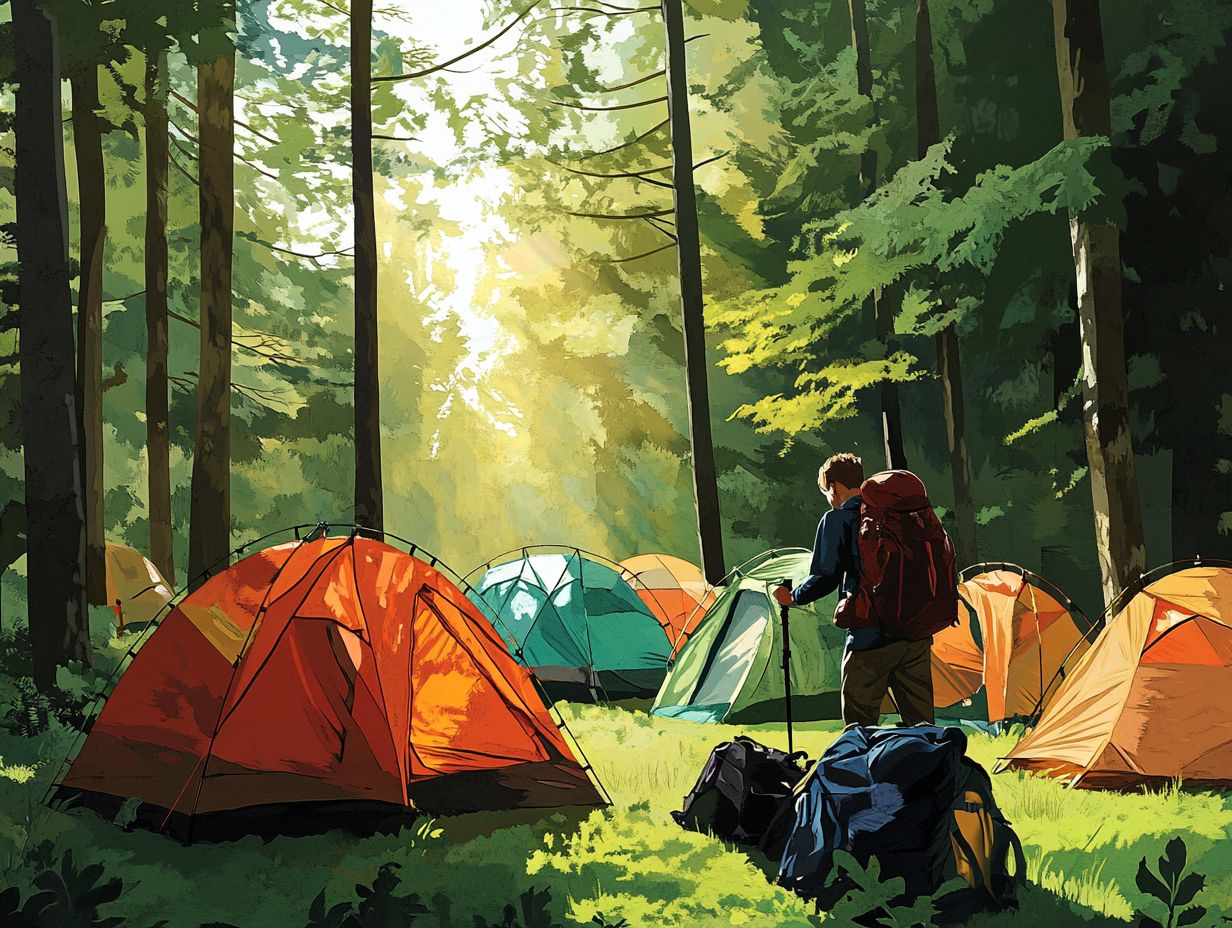
What are the key factors to consider when choosing the best lightweight tent for backpackers?
Some key factors to consider are weight, size, durability, and ease of setup. You want a tent that is lightweight enough to carry on your backpacking trips, but also durable enough to withstand different weather conditions, especially if you re considering an entry-level tent.
Are there any specific materials that make a tent lightweight?
Yes, there are a few materials commonly used in lightweight tents, such as Sil-Nylon, Dyneema, and aluminum. These materials are known for their durability and lightweight properties, making them ideal for ultralight gear.
Can a lightweight tent still offer enough protection and comfort for backpackers?
Yes, it’s definitely possible! Many lightweight tents come with features like waterproof coatings and ventilation options to keep you comfortable.
These tents are designed for backcountry camping, which means camping in remote areas without established facilities.
What is the ideal weight range for a lightweight backpacking tent?
A lightweight backpacking tent usually weighs between 2 and 4 pounds.
This can vary based on the size and design of the tent.
Are there any features that are essential for a lightweight tent for backpackers?
Absolutely! Look for a compact design, easy setup, and lightweight materials.
Features like pockets and a gear loft, which is a mesh shelf inside the tent for storing small items, can enhance organization and space.
Do I need to sacrifice durability for a lightweight tent?
You don’t have to sacrifice durability. Many lightweight tents strike a good balance between weight and durability.
Research and read tent reviews to find the best option for your needs!

